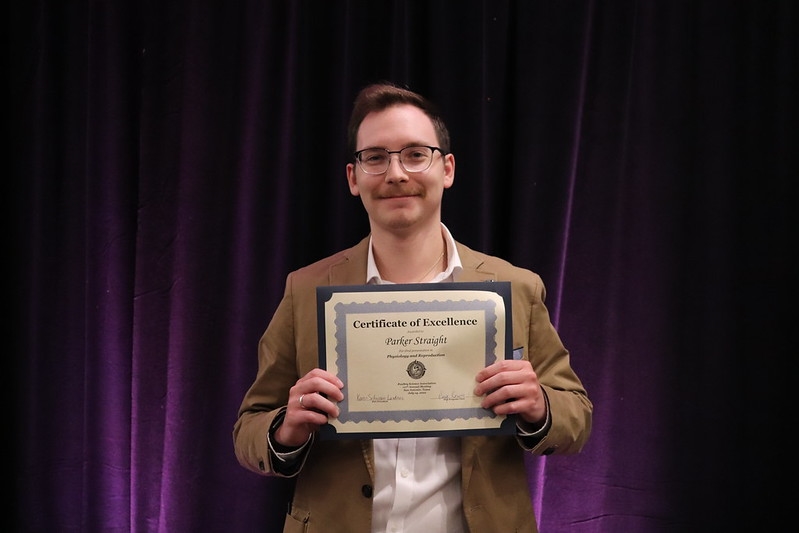
The neural pathways in a bird's brain can be very complex, prompting poultry scientists at the Arkansas Agricultural Experiment Station to employ 3-D imaging technology for research and teaching.
The Agricultural Experiment Station is the research arm of the University of Arkansas System Division of Agriculture.
Parker Straight, poultry science graduate student in Dale Bumpers College of Agricultural, Food and Life Sciences at the University of Arkansas, recently received the Award of Excellence for Best Oral Presentation in the area of physiology and reproduction at the Poultry Science Association Annual Meeting in San Antonio, Texas.
Straight and his research team wanted to model the tectofugal pathway, the primary visual pathway in chickens.
Two-dimensional visuals can only provide information on one anatomical plane within the brain of an organism. Three-dimensional techniques are vital for visualizing the complete set of structures, their connectivity and functions. Straight's team used histochemistry and diffusible iodine-based contrast-enhanced computed tomography (diceCT), with data reconstruction programs such as Brainmaker, Avizo and Blender, to create their 3-D interactive models.
"Histochemistry uses chemical reagents like dyes to stain tissue to allow it to undergo image analysis," Straight said. "DiceCT is very similar to an MRI but utilizes iodine to stain the tissue so that one can delineate groups of cells from fiber tracts, and this is imaged by using x-ray scans to 'digitally' slice the brain."
The iodine used in diceCT is not permanent and can be removed from the sample tissue without damaging or distorting the tissue, which is important for the integrity of the 3-D imaging.
"The beauty in the techniques that we're using is that they're reversible and non-destructive and allow you to obtain more accurate spatial and structural data for components of the neural systems," Straight said. "It is important to maintain the true natural structural formation of the brain to achieve high accuracy of things such as relative location, volume, linear dimensions and connectivity."
"What these methods can do is allow for the generation of complex models that can be used in both research and education," Straight said. "It allows students and those in the field to learn a complex pathway in a more effective manner."
Straight's research can be applied in a variety of scenarios, he said.
"It's important to show the application of the techniques I'm using, because ideally it can be used for other neural systems in birds and other vertebrates," Straight said.
Straight also presented his research at the International Symposium of Avian Endocrinology in Edinburgh, Scotland. There he was named runner up for the Early Career Researcher Award for his poster presentation. The two awards were determined by highest number of ballots cast by all delegates who attended the meeting and voted at the end of the poster sessions.
"I was overcome with satisfaction and validation for the work I have done, and I felt fulfillment knowing the research I am doing is meaningful," Straight said.
Straight's research team included Wayne Kuenzel, professor of physiology and neuroendocrinology at the Center of Excellence for Poultry Science and Paul Gignac, associate professor of cellular and molecular medicine at the University of Arizona. Funding for this project was provided by a Chancellor's Grant, awarded to Kuenzel and Gignac. Additional funding was provided by a grant from the Arkansas Biosciences Institute to Kuenzel.
To learn more about Division of Agriculture research, visit the Arkansas Agricultural Experiment Station website: aaes.uada.edu. Follow us on Twitter at @ArkAgResearch.
To learn more about the Division of Agriculture, visit uada.edu. Follow us on Twitter at @AgInArk.
About the Division of Agriculture: The University of Arkansas System Division of Agriculture's mission is to strengthen agriculture, communities, and families by connecting trusted research to the adoption of best practices. Through the Agricultural Experiment Station and the Cooperative Extension Service, the Division of Agriculture conducts research and extension work within the nation's historic land grant education system. The Division of Agriculture is one of 20 entities within the University of Arkansas System. It has offices in all 75 counties in Arkansas and faculty on five system campuses. The University of Arkansas System Division of Agriculture offers all its Extension and Research programs and services without regard to race, color, sex, gender identity, sexual orientation, national origin, religion, age, disability, marital or veteran status, genetic information, or any other legally protected status, and is an Affirmative Action/Equal Opportunity Employer.
Topics
Contacts
Jessica Wesson, communications manager
Department of Poultry Science
479-575-3327, jlwesson@uark.edu